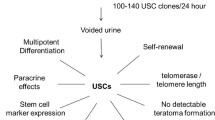Abstract
Upper urinary tract-derived urine stem cells (USCs) are considered a valuable mesenchymal stem cell source for autologous cell therapy. However, the reported culture condition for USCs is not appropriate for large-quantity production, because cells can show limited replicativity, senescence, and undesirable differentiation during cultivation. These drawbacks led us to reconstitute a culture condition that mimics the natural stem cell niche. We selected extracellular matrix protein and oxygen tension to optimize the ex vivo expansion of USCs, and compared cell adhesion, proliferation, gene expression, chromosomal stability, differentiation capacity, immunity and safety. Culture on collagen type I (ColI) supported highly enhanced USC proliferation and retention of stem cell properties. In the oxygen tension analysis (with ColI), 5% O2 hypoxia showed a higher cell proliferation rate, a greater proportion of cells in the S phase of the cell cycle, and normal stem cell properties compared to those observed in cells cultured under 20% O2 normoxia. The established reconstituted condition (ColI/hypoxia, USCsrecon) was compared to the control condition. The expanded USCsrecon showed highly increased cell proliferation and colony forming ability, maintained transcription factors, chromosomal stability, and multi-lineage differentiation capacity (neuron, osteoblast, and adipocyte) compared to the control. In addition, USCsrecon retained their immune-privileged potential and non-tumorigenicity with in vivo testing at week 8. Therefore, reconstituted condition allows for expanded uUSC cell preparations that are safe and useful for application in stem cell therapy.
Similar content being viewed by others
References
Biasini G, Rocchi L, Montaguti A. [The significance of epithelial cells in the urine of the newborn infant]. Riv Clin Pediatr 1967;80:442–449.
Felix JS, Sun TT, Littlefield JW. Human epithelial cells cultured from urine: growth properties and keratin staining. In Vitro 1980;16:866–874.
Wu S, Liu Y, Bharadwaj S, Atala A, Zhang Y. Human urine-derived stem cells seeded in a modified 3D porous small intestinal submucosa scaffold for urethral tissue engineering. Biomaterials 2011;32:1317–1326.
Zhang Y, McNeill E, Tian H, Soker S, Andersson KE, Yoo JJ, et al. Urine derived cells are a potential source for urological tissue reconstruction. J Urol 2008;180:2226–2233.
Bharadwaj S, Liu G, Shi Y, Markert C, Andersson KE, Atala A, et al. Characterization of urine-derived stem cells obtained from upper urinary tract for use in cell-based urological tissue engineering. Tissue Eng Part A 2011;17:2123–2132.
Chun SY, Kim HT, Lee JS, Kim MJ, Kim BS, Kim BW, et al. Characterization of urine-derived cells from upper urinary tract in patients with bladder cancer. Urology 2012;79:1186. e1-7.
Yokoyama T, Huard J, Chancellor MB. Myoblast therapy for stress urinary incontinence and bladder dysfunction. World J Urol 2000;18:56–61.
Wagner W, Horn P, Castoldi M, Diehlmann A, Bork S, Saffrich R, et al. Replicative senescence of mesenchymal stem cells: a continuous and organized process. PLoS One 2008;3:e2213.
van der Sanden B, Dhobb M, Berger F, Wion D. Optimizing stem cell culture. J Cell Biochem 2010;111:801–807.
Brinchmann JE. Expanding autologous multipotent mesenchymal bone marrow stromal cells. J Neurol Sci 2008;265:127–130.
Rodin S, Domogatskaya A, Ström S, Hansson EM, Chien KR, Inzunza J, et al. Long-term self-renewal of human pluripotent stem cells on human recombinant laminin-511. Nat Biotechnol 2010;28:611–615.
Hashemi SM, Soudi S, Shabani I, Naderi M, Soleimani M. The promotion of stemness and pluripotency following feeder-free culture of embryonic stem cells on collagen-grafted 3-dimensional nanofibrous scaffold. Biomaterials 2011;32:7363–7374.
Csete M. Oxygen in the cultivation of stem cells. Ann N YAcad Sci 2005;1049:1–8.
Yuan W, Zong C, Huang Y, Gao Y, Shi D, Chen C, et al. Biological, immunological and regenerative characteristics of placenta-derived mesenchymal stem cell isolated using a time-gradient attachment method. Stem Cell Res 2012;9:110–123.
Gordon MY. Extracellular matrix of the marrow microenvironment. Br J Haematol 1988;70:1–4.
Shattil SJ, Kim C, Ginsberg MH. The final steps of integrin activation: the end game. Nat Rev Mol Cell Biol 2010;11:288–300.
Yang XB, Bhatnagar RS, Li S, Oreffo RO. Biomimetic collagen scaffolds for human bone cell growth and differentiation. Tissue Eng 2004;10:1148–1159.
Kuraitis D, Giordano C, Ruel M, Musarò A, Suuronen EJ. Exploiting extracellular matrix-stem cell interactions: a review of natural materials for therapeutic muscle regeneration. Biomaterials 2012;33:428–443.
Jeong CH, Lee HJ, Cha JH, Kim JH, Kim KR, Kim JH, et al. Hypoxia-inducible factor-1 alpha inhibits self-renewal of mouse embryonic stem cells in vitro via negative regulation of the leukemia inhibitory factor-STAT3 pathway. J Biol Chem 2007;282:13672–13679.
Whitcomb EA, Dudek EJ, Liu Q, Taylor A. Novel control of S phase of the cell cycle by ubiquitin-conjugating enzyme H7. Mol Biol Cell 2009;20:1–9.
Rubio D, Garcia-Castro J, Martín MC, de la Fuente R, Cigudosa JC, Lloyd AC, et al. Spontaneous human adult stem cell transformation. Cancer Res 2005;65:3035–3039.
Chastain SR, Kundu AK, Dhar S, Calvert JW, Putnam AJ. Adhesion of mesenchymal stem cells to polymer scaffolds occurs via distinct ECM ligands and controls their osteogenic differentiation. J Biomed Mater Res A 2006;78:73–85.
Author information
Authors and Affiliations
Corresponding author
Additional information
These authors contributed equally to this work.
Rights and permissions
About this article
Cite this article
Chun, S.Y., Kim, H.T., Kwon, S.Y. et al. The efficacy and safety of Collagen-I and hypoxic conditions in urine-derived stem cell ex vivo culture. Tissue Eng Regen Med 13, 403–415 (2016). https://doi.org/10.1007/s13770-016-9073-6
Received:
Revised:
Accepted:
Published:
Issue Date:
DOI: https://doi.org/10.1007/s13770-016-9073-6




